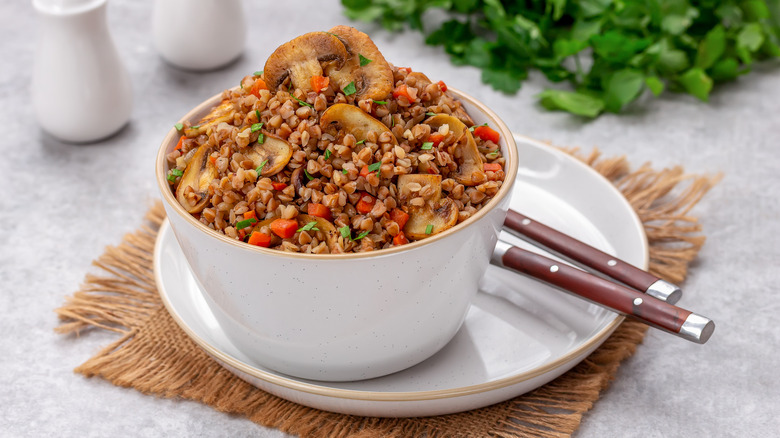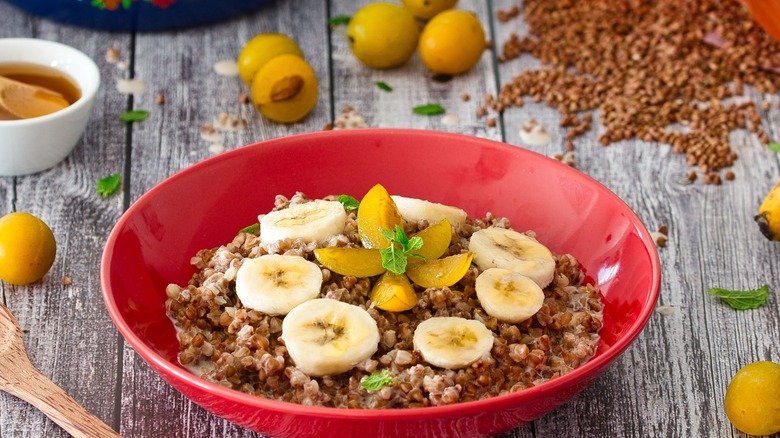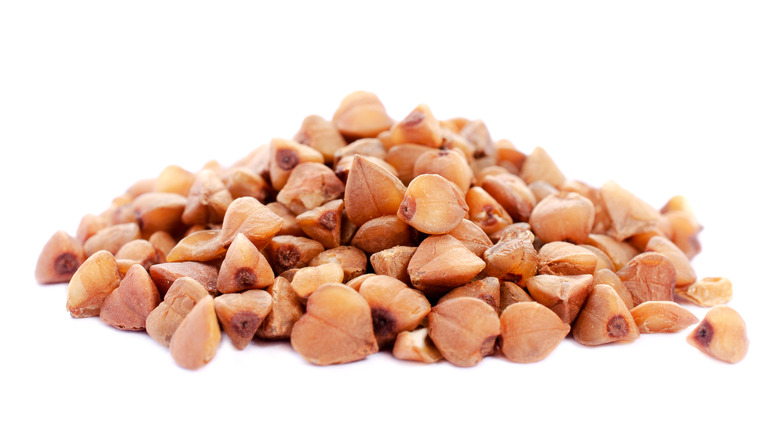Kasha: The Eastern European Staple You Should Have In Your Pantry
Quinoa, barley, farro, and more — there are many delicious grains and seeds to add to the pantry. Consumed in a whole range of dishes, from savory meat-based Armenian Harissa to fruit-filled quinoa energy bars, these kernels are extraordinarily versatile. Grains are deeply embedded into the human diet. Our appetite for these plants was critical to our evolution — with consumption spanning more than 100,000 years, says Scientific American.
Unique amongst these kernels is buckwheat, a pseudocereal that serves as the base for a variety of foods like soba noodles. Its seeds, called groats, are prepared in Eastern European porridges, such as kasha, via Britannica. Although associated with other grains, buckwheat is botanically different and technically classified as a seed. Completely gluten-free, the rhubarb-related plant does not have much in common with wheat grasses outside of culinary applications, per PEDIAA. Its unique characteristics make it all the more enticing as a pantry staple. Let's dive into kasha, the buckwheat porridge that's famous across Eastern Europe.
What is kasha?
In the U.S., Kasha refers to buckwheat porridge; however, the term can also apply to a wider range of porridges in Europe. Kasha can be eaten for any meal of the day. Prepared sweet and savory, hot or cold, the food has long been a staple in Eastern Europe. Moreover, its affordability and ease of preparation have carried it across the globe with emigration, such as with the Jewish diaspora in New York City, notes Dana Modell in "Kasha: The Mighty Buckwheat Groat."
In Russia, the dish is culturally meaningful; it is often the first solid food introduced to a child and served during funerals, feeding people across their entire lifespan, according to Taste Atlas. The other kasha varieties are no less popular than buckwheat, with rice, wheat, and millet variations commonly consumed (via Taste Atlas). An especially famous porridge rendition is mannaya kasha, made with semolina. Also known as cream of wheat, this thick white porridge was widespread throughout the Soviet Union and continues to be popular, served in preschools, office cafeterias, and at home — much like the buckwheat variety, per Russia Beyond.
History of kasha
Out of the various porridge bases, buckwheat was one of the last to be introduced to Russia, but it rapidly spread throughout the country. It soon became a cornerstone of Russian cuisine, per Advantour. Kasha has appeared throughout significant historical events. A porridge feast was prepared on the wedding of Alexander the Great in Novgorod, and Peter the 1st was particularly fond of the kernel. Prepared for both crownings of monarchs and by the common people, porridges historically permeated all social classes (via Russia IC).
In large part, kasha's prominence is due to geography. Russia's large swaths of land and diverse soils accommodate the grain well. Buckwheat has a short growing season, with maturation occurring in only 30 days. It thrives in less fertile, acidic soils that are common throughout the Slavic nation. Such malleable conditions and ubiquitous consumption have now made Russia the world's leading producer, reports World Atlas.
How kasha is prepared
The preparation of buckwheat kasha is relatively straightforward — simply boil the seeds in water for about 6 to 7 minutes. There should be a hint of mushiness, but the seeds should retain a rigid feel. If it turns out too gummy, add less water, and boil for a shorter time. Typically, each cup of buckwheat requires a cup and a half of water, according to The Spruce Eats.
In Russia, the old-fashioned preparation involves a pechka — a large oven inside a home's living room. The porridge is simmered on top of the oven at low heat, yielding the ideal texture due to the even heat application. During cooking, on both modern and traditional stoves, the buckwheat should never be stirred. Salt, eggs (both boiled and fried), and dill are common toppings, notes Folkways. Most often, it's eaten on its own as a meal or as a side dish. Sometimes, it's added as a component to salads, sweet dishes, or combined with pasta (a traditional Ashkenazi dish).
With such an easy preparation and diverse array of applications, there's always a place for kasha in the pantry. Eat it as the Russians do for breakfast, lunch, or dinner.



